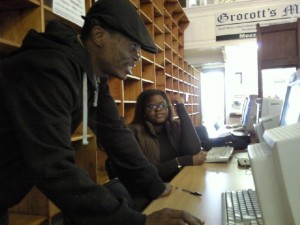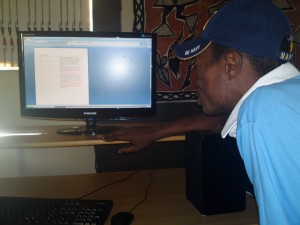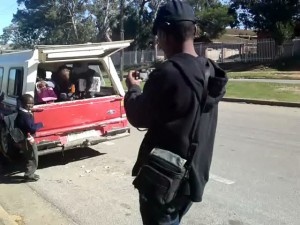This is a profile on Grahamstown Inspector Williams.She is passionate about her job and is proud to be one of the few female inspectors in the male dominated field.She has been successful in striking the right balance between home and work
Archive for May, 2010
Our “graduated” citizen journalist with a tight schedule!
It wasn\’t easy, but it was hope that pulled us through
By: Bongeka Gumede and Nonceba Mhlauli
Working with Andile Nayika was a challenging yet fulfilling and rewarding experience for us. He was eager to learn yet highly constrained by time and other commitments and this posed a great problem for us in the beginning. As time went on however, we became accustomed to his time schedule and managed to work around this issue.
The first time we met Andile he seemed quiet, reserved and very busy. Having recently been promoted from being a citizen journalist to an intern, he appeared as though he was too pre-occupied with trying to find his feet as a new intern at Grocotts Mail. We suffered from time constraints. Since Andile had recently lost his phone we also lacked a video camera which was needed for his stories and furthermore, as a consequence of having no phone there was a communication barrier which meant that we could not easily get a hold of him. In spite of all these obstacles, we overcame and managed to complete the tasks laid before us as a team.
From our very first meeting with Andile it was evident that he had a lot of knowledge about news and journalism in general, he had many great story ideas however they were only conducive for newspaper articles and we had to assist him to channel his mind towards story ideas which would be rich in visual content. We had to encourage him to move away from stories that contained a lot of facts which could only be expressed in words and to focus on the visual element of a story instead.
Andile’s interest in stories pertaining to service delivery issues took us by surprise. We expected him to be an arts-oriented person since we were aware of his love for poetry and other forms of entertainment as well as interest in youth issues. He felt very strongly about the fact that the children in his neighbourhood are forced to play near a dumpsite due to lack of recreational facilities and we encouraged him to pursue this story.
Once Andile had decided on a story we shared our knowledge of how to make a video with him. We told him the basics about the five-shot rule, the rule of thirds and how to shoot good sequences. We taught him how important the elements of sound and lighting are in a video as well as how to ensure that the sound and the light came out right in a video. He grasped the concepts easily and this understanding was reflected in the first piece that he was assigned to do. We were pleased with the outcome of his 10 second video clip as well as the blurb which accompanied it.
For the second assignment we had to assist Andile to produce a 30 second- 1minute clip and for this task, he chose to expand on his dumpsite story which we thought was a good idea. Unfortunately, however, it became very difficult to get a hold of Andile after the first assignment and once we did get a hold of him we could not set up a time convenient for all of us because his own work as an intern at Grocotts Mail was demanding and time- consuming to the point where the work we needed him to do was becoming a burden to him.
He embarked on the mission to cover the dumpsite story all on his own and we were unable to accompany him since his tight schedule meant that he would have to shoot the video during awkward hours on his way to work. The work was done in a haphazard manner and the video clips were largely difficult to use. This can perhaps be accounted for by the fact that he was swamped with other work and commitments.
We decided to set aside a day we would go to the townships and guide him in the shooting process. The extra time we invested was worth our while because the shots which Andile took were of a much better quality. It turned out to be a great day where we got to interact and acquaint ourselves with our “graduate” citizen journalist on a personal level. After shooting, we went to visit Andile’s place since it was located a short distance from where we were shooting the dumpsite story. He welcomed us into his home and we got to socialise with him in his personal space where he felt comfortable and free to be himself. We discovered that he was very down to earth with a respect for the spirit world, love for people, music and poetry. We also learnt that Andile is very much a self-subsistent and independent person who works hard to advance himself and rise above his circumstances. Journalism for him is a career which he enjoys pursuing whilst also investing time in his management studies.
During the editing process, we worked together as a team with Andile and guiding him on the structure of his narration as well as the editing of his clips. He was very much involved in the process of narrating and seemed to have a natural ability to use the right words to tell his story. In terms of cutting clips he was largely apathetic and did not really spend time familiarising himself with the editing programme. During the recording of the narration, Andile was articulate and clear, however the tone of his voice sounded very much like a radio presenter and therefore the narration had to be recorded a couple of times and he displayed patience, perseverance and a willingness to learn through it all.
We were pleased with the outcome of Andile’s work. We may have faced a lot of challenges in the beginning but Andile was persistent and he co-operated whenever it was within his power. We were also patient and accommodated his busy work schedule throughout the process.
We also believe that working with our citizen journalist assisted us to enhance our own skills and to put our knowledge to the test. It was a highly rewarding experience to be able to pass on what we had learnt to someone who had so much dedication towards journalism and who we were certain would put the knowledge to good use.
Working with Thembeni: Citizen journalism
Despite our anxieties, however, luck was on our side. Thembeni was praised by the Chief editor of Grocotts, Kwanele Bhutane as being one of the best citizen journalists Grocotts had, having published several stories on the Grocotts mail website over the last few months. This would be an advantage when it came to finding stories to film because it meant he already had a sense of what was newsworthy and what was not. When we finally did meet, we shared brief hellos and got right down to work. Tamsin and I explained to Thembeni the fundamental aspects of filming stories such as the difference between finding stories for print and finding stories for television. We explained the meaning of terms such as ‘visually compelling’, ‘six second shot rule’ and lighting. His countenance at this point had shifted from jovial to worried (a look we would come to see plenty of over the next few weeks!) and Tamsin and I attempt to calm him repeating that it was not as hard as it sounded to film stories once you ‘got the hang of it’.
For that first week we assigned Thembeni to film a ten second clip of news stories he was already working on for Grocotts as a print stories. The first story was that of the illegal transportation of school children in vans which was deemed unsafe by the South African Government. The second story was covering the march that had been organised by Mary Waters high school students outside the Magistrates court, to protest the bail applications of two men, who allegedly raped a female student from their high school. The clips Thembeni filmed were very good for first attempts at filming and even included a skill we had not taught him, panning! After congratulating him on his work, we wasted no time in planning for the next assignment, a one minute piece which would undoubtedly require more effort on both mine and Tamsin’s side, as well as that of Thembeni.
We agreed that a continuation of the Mary Waters story he would be telling with one of the ten second clips would be ideal and were exhilarated to learn that Thembeni had heard rumours of community members wishing to demolish the abandoned house where the rape occurred. By removing the scene where the horrific incident occurred, the community wanted to show their intolerance for such crimes and prevent a repeat of the same crime befalling another student (since the area around the house was surrounded by schools). In high pitched voices laden with excitement Tamsin and I explained the potential behind capturing bulldozers ripping down walls with community members tearing up, watching on the sidelines. Filming stories had certainly made an impression on what counted as excitement in our lives! Unfortunately when the day came for us to accompany Thembeni to shoot the story, we were disappointed to find that the demolition team consisted of two men who were taking apart the roof and probably would not get around to tearing down the walls until at least 2 weeks later. We did however make the most of it and shot as much footage of pounding hammers as possible instructing Thembeni afterwards on how to shoot sequences. Once again, those familiar worry lines appeared on his face and once again Tamsin told him not to worry!
When Thembeni was free one afternoon we invited him up to the journalism department where we showed him what we meant by sequences by making him watch our how to videos. At that point he understood what we had trying to explain to him and managed to film at least 3 sequential shots for the final story. Up until this point we had suffered no horrendous hiccups, but a large one loomed over us like a dark cloud and would release its might as soon as we would start editing!
Formats formats formats! The one downside of working with cellphone footage is having to change various formats into other formats before using editing software designed for ‘proper cameras’. Despite the problems it gave us, Tamsin and I stuck with Windows Movie maker as we felt it would benefit Thembeni to learn how to edit on it, since he could access it through the Grocotts computers. After converting his footage from QuickTime., to wmv. we started the editing process and quickly learned that Windows Movie Maker was not necessarily as difficult to use as Adobe Premier Pro, (the software we were taught how to use in first term) it was just twice as slow and gave us twice as many problems, freezing constantly. Eventually we did finish editing it, with narration. Thembeni, having worked as a newsreader at Rhodes Music Radio required little guidance apart from pace instruction, when recording his narration.
When reflecting on the whole experience of working with a citizen journalist Tamsin and I agreed that while it was much easier to work with a television crew that knew just as much as you did, it was good feeling to know that you helped teach someone something they otherwise might have never known. The live television show was a pleasant way of marking the end of our working relationships with Thembeni, after all that hard work he was able see what it was all for.
View Thembeni Plaatjie’s story map in a larger map 
Teaching: a two-way process
By Tessa Trafford and Nicole Bloch.
Citizen journalism refers to the gathering, analysing and reporting of news by community members. Grocott’s Mail opened a Citizen journalist Newsroom in September 2009, and has since been training pro-active community members to become journalists. As part of this project, television journalism students from Rhodes University joined with the citizen journalist to further train them in the broadcast medium.
The citizen journalism project turned out to be a challenging journey for us as well as for Noxolo Saki, the citizen journalist. In order to be able to teach more efficiently after a short term of doing television journalism ourselves, we decided to make a manual for Noxolo which included basic information on filming, searching for a story and editing. The first big obstacle however was to get Noxolo a phone with video, as she did not have access to one. It would have been possible to get a different citizen journalist with a phone but we did not want to disappoint Noxolo and we did everything in our power to keep her in our team. A Journalism and Media Studies professor at Rhodes University then provided financial support in order to get Noxolo a phone for the project. The search for a phone and the fact that Noxolo has a two year old child caused huge time constraints. Although Noxolo started out extremely shy and did not know how to look for a good story, she soon came out of her shell and started to show some good results. In order to get some practise Noxolo was required to film a short video clip. Noxolo decided to film a clip on a church group donating boxes of fruit to the House of Joy, where many orphaned children are staying. In the clip, the owner of the house gives thanks to God.
After having had this practice Noxolo started to film for the main project. She focused on a story about litter being dumped behind a crèche in Joza, which is affecting the health of children and angers community members. The crèche is opposite Noxolo’s house making this a personal issue as well as one of great importance to the community. This makes the story hyper-local. One of the major advantages of Citizen Journalism is that community members can let their voices be heard about issues that other journalists may not be aware of.
The highlight of the citizen journalism project was the talkshow, where Noxolo’s video was played alongside that of the other citizen journalists. The video was followed by an in-studio discussion where Noxolo, who was part of the audience, was able take part in the show. To get the full story, plus more pictures and video clips, go to our timeline:
This gives you a timeline, with information and images, of the citizen journalism project.
From this project we learnt that teaching is a two way process. While we taught Noxolo about the world of broadcasting and how to create effective videos with a cell phone, we in turn learnt new skills from Noxolo as well as from the teaching process itself.
Going forward with Citizen Journalism
By: Zikhona Masala and Pumelela Nqelenga
The collaboration of JMS3 students along with Citizen Journalist trainees from local newspaper Grocott’s Mail was comprised of 6 weeks of basic journalism training. As JMS3 students our mandate was to work in a team with citizen journalist trainees throughout the duration of 2nd term. However this was not without any challenges, we had to school ourselves in using a new programme Windows Movie Maker instead of the usual Adobe Premier when compiling stories, on the other hand teaching the citizen journalist as well as having to send out search parties in order to make sure that our citizen journalist was on track with assignments. Our citizen journalist was Zoli Pamela Sakata a communications major who because of this already had a general idea about interviewing techniques, camera shots which were all done using her Samsung B3310 cellphone.
Another challenge was the use of cellphone’s as citizen journalism requires instead of using television cameras. Often the camera quality was not as good as it would have been on an actual TV camera but we did manage to find ways in minimizing such encounters. The upside of using a cellphone was that we didn’t have to carry heavy and huge camera’s, this made it easy for our citizen journalist to move around easily when capturing footage. Our duty was to help and guide our citizen journalist’s through using a cellphone and making video clips that would be used by a news organisation, in this case it was for the Grocott’s Mail website.
Zoli learnt the skill of taking shots using the 6 seconds rule, getting B-roll and cutaways, sequencing, capturing, working with audio and doing narrations. As part of our duty we also had to help and work with her in the process of finding viable story angles that would be suitable for the television medium in particular. Looking back at the very beginning of the course, the first video clip that our citizen journalist took, it is visible that there has been tremendous improvement in terms of ideas and the footage that our citizen journalist is now able to do. During this process as JMS 3 students we were not just teaching the citizen journalists, we were also learning by showing them the ropes, we are confident that Zoli is now well equipped to provide her community with good quality news of public interest and will hopefully continue using her cellphone as a tool to do so.
View T St in a larger map
View Grahamstown in a larger map
View Grahamstown in a larger map
RDP Housing Issues in Grahamstown
The Makana Municipality is accused of failing to assist members of Grahamstown east with housing problems caused by the heavy rains experienced last year. Michael Bhusakwe is a victim of Grahamstown’s infrastructural problems and Duduestsang Makuse reports on his situation.





